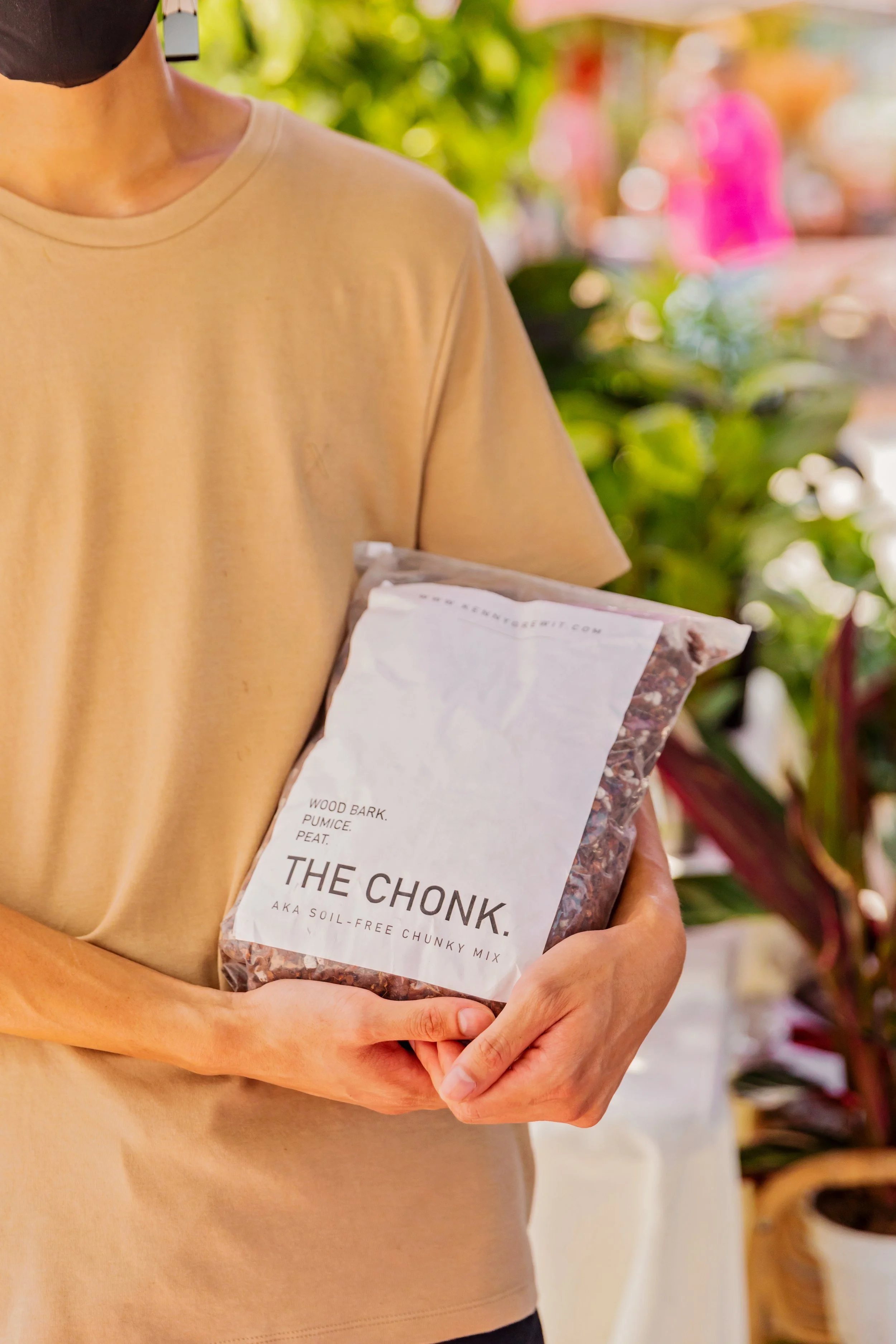CHONK
Here are some tips to help you get started with The Chonk.
POTTING
You can feel safe transplanting any plant into The Chonk! It’s been tested to work with just about every genus, even calathea, peperomia, and ferns!
Start by loosening any of the existing soil from your plant’s roots. They don’t need to be perfectly clean, just make sure to break up any clumps as these can hold too much water and cause localized rot. Our goal is to get oxygen evenly distributed throughout the root zone!
Fill the container about 1/3 full with Chonk and place your root zone on top of this (1/2 is even better, if you can manage without the plant falling over!) This will allow you to keep your plant in a reservoir (if you choose) without the roots being submerged in the water.
You can repot plants from ANY substrate into The Chonk, including from LECA, water rooting, PON, moss, etc.
-
For plants with delicate roots, loosen as much soil as you can from the bottom of the pot and work your way up into the root zone until it becomes difficult to loosen anymore soil.
Fill a pot with Chonk and place the remaining soil and root zone on top of the Chonk layer, and fill in any gaps with Chonk.
Because the upper half of the pot typically dries out faster anyways, it will match dry times with the much more aerated bottom half and your plants will be safe from root rot.
It’s not worth damaging precious roots just to get perfect cleanliness!
WATERING
When you first repot a plant in The Chonk, fully submerge the substrate for 10-15 minutes to hydrate all particles. Wood bark and peat moss can become hydrophobic when fully dried and need to be rehydrated in order to become receptive to water again.
Water every 3-5 days when you notice the top inch of the medium is dry. You don’t have to be afraid of watering too much in The Chonk thanks to the incorporated oxygen, so feel free to water more frequently. If the medium dries out all the way, soak it again. The goal is to always keep the medium watered and to never have it dry out fully.
FERTILIZING
We do not add ANY fertilizers to your substrate. Why? Things like worm castings become useless once their nutritional value is used up and just clog the oxygen pockets. Slow release ferts can fluctuate greatly based on a variety of factors, and there’s no way to tell when the fertilizer has run its course and needs to be replaced. Pre-fertilized substrate is a marketing ploy that can leave your plants with deficiencies and wildly unpredictable growth.
As recommended by Michigan State University, you can fertilize at half-strength every watering and ‘flush’ on the fourth watering by watering with plain water and allowing it to run out of the pot freely for a couple seconds. Flushing resets any mineral imbalance and salt buildup that occurs from fertilizing and prevents mineral lockout.
-
Our favorite fertilizer is Dyna-Gro Foliage-Pro 9-3-6 because it contains the full spectrum of micro and macro nutrients that plants need for growth. This is called a complete fertilizer, which differs greatly from other incomplete fertilizers competitors such as Superthrive and Liquidirt.
We’ve noticed the best growth when also supplementing with CalMag 2-0-0 and Dyna-Gro Pro-Tekt. The Pro-Tekt is optional for silica, but if you have to choose one, we would highly recommend the CalMag. An analysis of plant leaf litter from Michigan State University shows that tropical plants use a MUCH greater amount of calcium and magnesium than is provided in the current fertilizers on the market. While Foliage-Pro excels in every other way, it does fall into this category.
TIPS
1
If the top half of your medium is drying much faster than the bottom half, you can pack the top of the pot with a 1/2 inch layer of long fiber sphagnum moss. This will help even the dry time throughout the pot and add some ambient humidity to the immediate area.
2
Importing some plants? The Chonk is a perfect medium for helping your plants re-root and acclimate. Many users of The Chonk pot their Ecuagenera philo/anthurium or AH Hoya imports directly into Chonk upon receipt and keep them watered and in high humidity. They’ll bounce back soon enough and there’s no need to repot them again like you’d have to in other mixes— which would just stress them again!
3
If you want to stretch your supply by adding other amendments, you can add anything that is larger than 1/4” in diameter. Do NOT add anything finer (worm castings, coco coir, more peat, etc.) as it will clog the oxygen pockets and cause root rot.
4
The Chonk can also work with a reservoir of water through “bottom watering.” You can set it in a tray or dish of water and let the mixture wick moisture up. When using this method, be sure to still maintain a flushing routine and let the reservoir dry out for 24 hours once every few weeks. The substrate must be thoroughly hydrated for this to work, so be sure to submerge/soak your entire pot overnight before starting.
Need some specific questions answered? You can always message me on Instagram or send me an email at howdy@kennygrewit.com!
